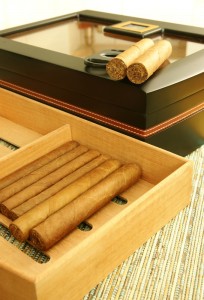A Quick Guide To Aging Cigars

Cigars and wine have a lot in common. Both are appreciated for their depth of experience, and how they reward those who pay attention to quality. Also, both undergo changes as they age. Just as a wine can truly mature through the aging process, so can a cigar. Here’s a brief overview on aging cigars.
Right off the bat, if you want to sample aged cigars, you don’t have to wait a few years. Many cigar makers age cigars and then we in turn sell them, so you can just walk in and sample a taste from 10 or 15 years ago.
Aging cigars at home has its own rewards, though. For one thing, you can sample them along the way to see how they change over time. A young cigar generally has a bolder, more up front taste profile, while an aged cigar is mellower and more nuanced. Think of them like people, if that helps you remember.
The most important variable in aging cigars is stable storage. If your storage method isn’t consistently correct, you’ll simply ruin perfectly good cigars over time. You’ll want a spacious humidor, with as much or more open space as you have cigars inside. The humidor should be lined with cedar, and seal properly so there aren’t fluctuations in humidity and temperature. Keep your humidor away from direct sunlight, which can rapidly increase the temperature inside.
When it comes to picking the cigars for aging, remember that bigger is better. Thicker cigars have more tobacco and a wider variety of tobacco inside, which lends to more dramatic changes during aging. A slim cigar might not change much over time. Also, cigars that are cured with a dark wrapper may not mature in any noticeable way.
If you do decide to age some cigars, keep a diary so you can track the changes over the years. Maybe smoke one every 6 months and note the changes and the tastes that emerge. If you want some recommendations on cigars for aging, or want to look into a solid humidor, stop by our shop, we’d love to help you out!